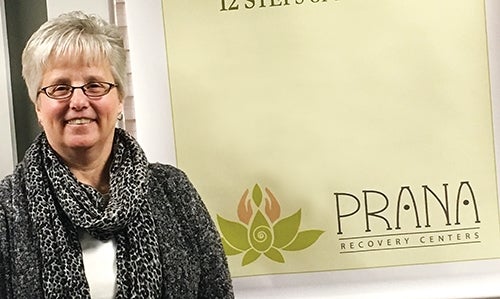Kelly McCausland understands the effectiveness of yoga and mindfulness as tools for recovery on a very personal level. McCausland, who started practicing yoga as part of her recovery from drugs and alcohol, integrates yoga and mindfulness, as well as exercise, nutrition, the science of happiness, and the 12 steps of Alcoholics Anonymous into the recovery program at Prana Recovery Centers, the Marlborough-based relapse-prevention program she founded in early 2016. So far, about 15 people have been through her 12-week program, a pay-as-you-can model designed for anyone who is at least 14 days sober and looking for recovery support.
What’s your connection to wanting to help people with substance abuse disorder?
I’ve been in recovery myself for almost 20 years. I was struggling in recovery. I was getting overweight and my back hurt, and somebody suggested yoga. I didn’t know when I put a rented mat down that it was the front row. I was in sweats and a sweatshirt and the room was heated to 90 degrees. And most of the time, I was looking around, thinking, “You want me to do what?!” But I walked out of there and I knew something was dramatically different.
What’s your program structured around?
We have six pillars of wellness: mindfulness, the science of happiness, the 12 steps of Alcoholics Anonymous, yoga, exercise, and nutrition. Every session starts with a mindfulness practice. We call it a “sit.” Every session ends with either a yoga practice or a body scan meditation.
What’s the science of happiness?
Social science researchers are finally studying what’s right with us humans rather than what’s wrong with us. It looks at questions like, “if we practice gratitude, generosity, compassion, and kindness over specific and intentional periods of time, how does that affect our happiness level, and what is our happiness level anyhow? And how much control do I have over that?”
Who can come to Prana?
You have to be at least 14 days sober. Folks come to us usually from a detox or residential treatment center so they’ve come back to their community. We offer relapse prevention, because that’s usually when we lose people, especially heroin addicts. Their bodies are clean because they’ve come from detox and residential treatments, but they come back to the reality of the stressors of life and that’s why we want to provide support for them.
What sets you apart from other programs?
We are experiential and not therapeutic. You don’t just consume, you have to engage. You can’t just sit there and pretend to be listening.
We have a participant who started his mindfulness practice with us, and he went looking for community resources. And he kept saying, “I feel this gap. When I’m sitting to meditate, there’s this gap.’ and finally one night he said, ‘I think I hit on the gap,” and he went on for 35 minutes around some very deep, disturbing childhood trauma that he has never spoken about before. Because he’s sitting with himself in meditation, the body remembers. Once he shared, we connected him with a trauma specialist.
It can help people realize what they need to talk about when they go to a therapist. A lot of alcoholics and addicts have trauma in their lives. And of course, not everybody has that experience. Some folks come to Prana and find within the six pillars enough to happily live clean and sober.
Why did you want to start Prana?
Too many people die. Many people have this journey, because life has become unmanageable. You go to detox, and you’re told what to do from the time you get up to go to bed, and it can be anywhere from two weeks to nine months, depending on a lot of things. You do physical detox, then you do structured living, then you go home. There’s a big difference between structured living where you’re told what to do every day, to home, where there are bills to pay, relationships to heal, and responsibilities to manage.
The other reason is many residential rehabs offer yoga and mindfulness as an ancillary event to their programs. We believe that mindfulness and yoga should be available to all people. The only places where it’s integrated as part of the program are at the very high-end rehab centers; many of them are on the Pacific Coast Highway in Malibu. We believe that mindfulness and yoga and these other pillars should be available regardless of your ability to pay.
This interview was conducted and edited for length and clarity by Laura Finaldi.

